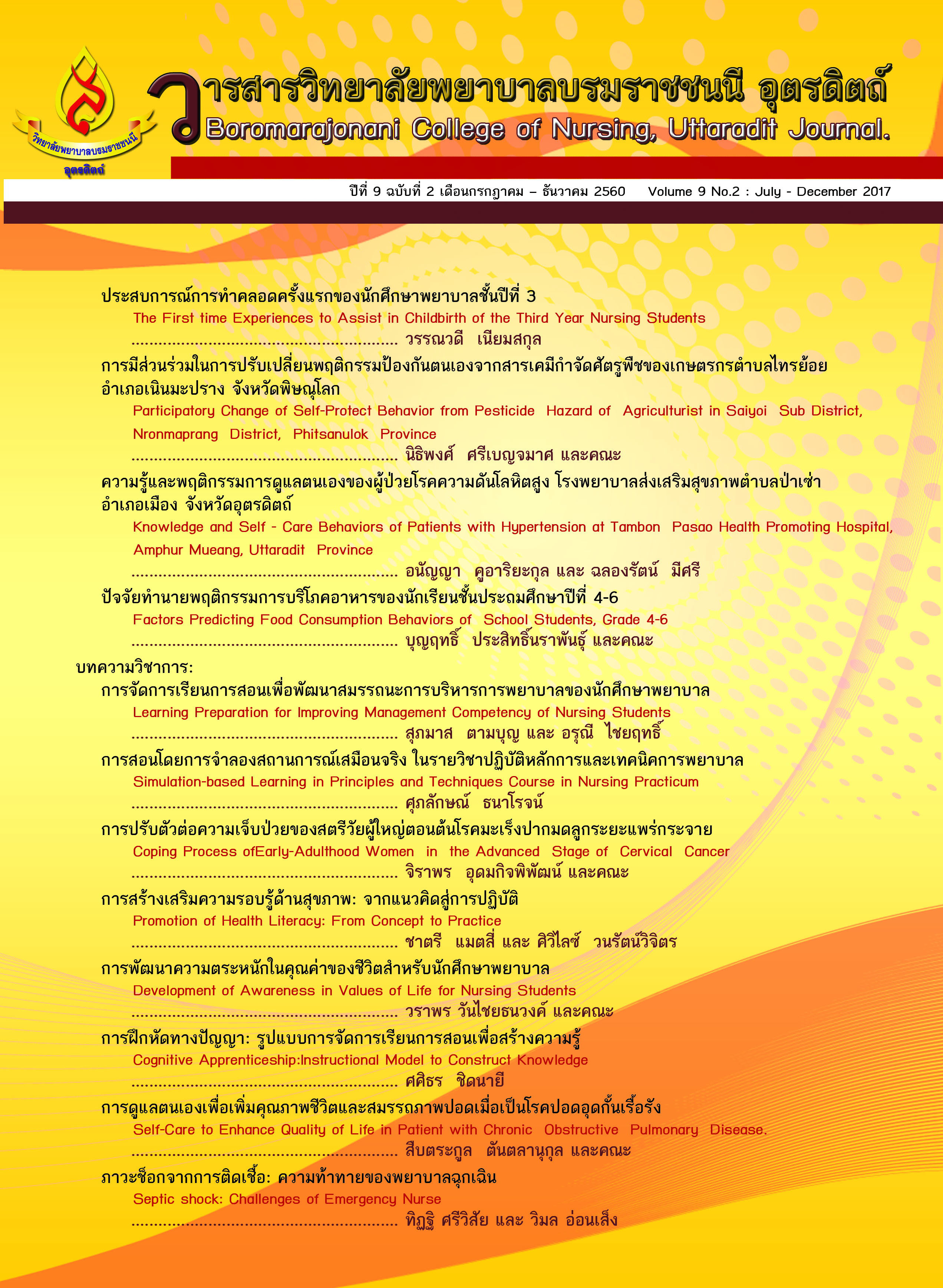การจัดการเรียนการสอนเพื่อพัฒนาสมรรถนะการบริหารการพยาบาลของนักศึกษาพยาบาล
Main Article Content
บทคัดย่อ
Learning preparation for improving nursing administration competency of 4th year nursing students of Boromarajonani College of Nursing Phra-putthabat aimed to improve competency team nursing management and quality of care management for the patient using the discharge planning procedure, including as follow: 1) practicing on ward in the role of incharge, 2) practicing to use discharge planning, and 3) knowledge management of nursing administration. The results showed that all 4th year nursing students achieve the criteria of management competency. The significant factor of success to enhance ability of nursing management that included: 1) learning from role model of preceptors and supervisors, 2) student factors as professional experience development and frequency reviewing academic knowledge, and 3) learning climate factors including cooperation from health care team and participation in team of students, learning environment supporting studying and supporting to practice
nursing skill.
Article Details
บทความหรือข้อคิดเห็นใดใดที่ปรากฏในวารสารวิจัยการพยาบาลและวิทยาศาสตร์สุขภาพ เป็นวรรณกรรมของผู้เขียน ซึ่งบรรณาธิการหรือสมาคมศิษย์เก่า ไม่จำเป็นต้องเห็นด้วย และบทความที่ได้รับการตีพิมพ์เผยแพร่ถือเป็นลิขสิทธิ์ของวารสารวิจัยการพยาบาลและวิทยาศาสตร์สุขภาพ
เอกสารอ้างอิง
2. Jormsri, P., Klunklin, A., Tunmukayakul, O., & Srisuphan, W. (2010). Perception of Nursing Principles among Nurses in Thailand[Electronic version]. Thai Journal of Nursing Council,25(1), 27-37. (in Thai)
3. Kunsiripunyo, J. (2015). The Development of Criterion On Evaluation Register Nurses Competencies. Journal of The Royal Thai Army Nurses, 16(2), 123-130. (in Thai)
4. McClelland, D.C. (1993). Testing for Competence rather than for intelligence. American Psychologist. 28(1), 1-4.
5. McKeehan, K.M. (1981). Continuing care :A multidisciplinary approach to discharge to discharge planning. St.Louis : C.V. Mosby.
6. Phanich, V. (2003). Knowledge Management. Retrieved from http://qa.siam.edu/ images/KM_Article4.pdf (in Thai)
7. Praboromarajchanok Institute for Health Workforce Development. (2012). Copy of Curriculum Nursing (Approved in 2012). (in Thai)
8. Phothidara, Y. (2011). Nursing Education Management : For Student Generation Y. Journal of Nursing Science & Health. 34(2), 61-69. (in Thai)
9. Rakdee, R. (2013). Professional Nurses’ Service Behavior Perceived by Inpatients of Charoensin Hospital, Sakonnakhon Province. Thesis of Master Degree Nursing Administration, Faculty of Nursing, Burapha University). (in Thai)
10. Raetong, P. & Harnirattisai, T. (2012). Role Change Experience : From Nursing Students to Registered Nurses. Thai Journal of Nursing Council. 27(2), 51-62. (in Thai)
11. Rungvachira, O. (2016). Nursing Management On Ward. [Power point]Retrieved from http://www.teacher.ssru.ac.th (in Thai)
12. Sherwood, G. D. and Horton-Deeutsch, S. (2012). Reflective Practice : Transforming Education and Improving Outcomes. Indianapolis : Sigma Theta Tau Press.
13. Thailand Nursing and Midwifery Counsil. (2009). Announcement of Thailand Nursing and Midwifery Council : Competency of Professional Nurse. Retrieved from https://www.tnc.or.th./news_detail.php?news_id : 123.(in Thai)
14. The Healthcare Accreditation Institute (Public Organization). (2014). Step 2 Essential : From standard to practice. Retrieved from https://www.ha.or.th/TH/Article. (in Thai)
15. Thipfun, C., Chitpakdee, B., & Keitlertnapha, P. (2014). Development of Preparation Program for Being Charge Nurses. Nursing Journal. 41(1), 145 – 157. (in Thai)
16. Thummickabowarn, S. (2011). Holistic Nursing Care : Case study. Bangkok : Thanapress Co.,Ltd. (in T้hai)


